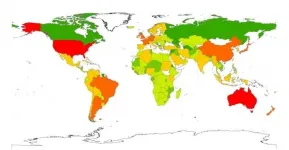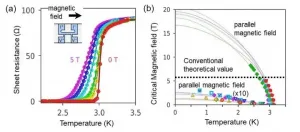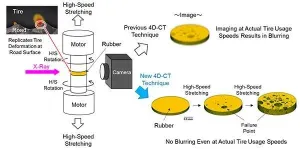(Press-News.org) Remote monitoring using airborne devices such as drones or satellites could revolutionise the effectiveness of nature-based solutions (NBS) that protect communities from devastating natural hazards such as floods, storms and landslides, say climate change experts from the University of Surrey.
Grey structural measures (a collective term for engineering projects that use concrete and steel) like floodgates, dams, dikes and sea walls are still the most common methods to guard against natural hazards. However, these 'grey measures' are expensive and lack the long-term flexibility and sustainability needed to help communities manage their growing population and address the planet's ongoing struggle against urbanisation and climate change. While NBS are cost-effective, their usability and reproducibility are often hindered by the lack of standard monitoring methods, tools and indicators.
In a comprehensive study published in the Earth-Science Reviews journal, researchers from Surrey's Global Centre for Clean Air Research (GCARE) collaborated with experts from across Europe* to analyse monitoring methods that measure the effectiveness of NBS - such as wetlands, forest restoration projects and installation of green walls.
In the paper, the team found that while there is a need for combining ground and remote monitoring methods for holistic assessment, the advances in remote monitoring techniques present a significant source of hope for routinely, continually and accurately measuring the effectiveness of NBS and quelling skepticism around choosing NBS over grey-engineered options. Remote monitoring offers the ability to cover large geographical areas, and high-resolution imagery could change the way farmers, scientists, hazard managers and other decision-makers view NBS usage and applicability.
However, the study also warns that the lack of globally accepted standards to gauge an NBS success hinders their progress and use and needs to be urgently addressed.
Professor Prashant Kumar, Associate Dean (International) and the Director of the GCARE at the University of Surrey, said: "Unfortunately we do expect a significant uptick in natural hazards, thanks to climate change. Therefore, our decisions on how we protect ourselves are crucial, and nature-based solutions have the advantages of being flexible and not adding to the damage caused to our environment.
"I hope that this review begins an urgent discussion on how we can move forward as a scientific community and start to develop an accepted framework for measuring the effectiveness of nature-based solutions."
INFORMATION:
Note to editors
Reference
Kumar, P., Debele, S. E., Sahani, J., Rawat, N., Marti-Cardona, B., Alfieri, S. M.,Basu, B., Basu, A. S., Bowyer, P., Charizopoulos, N., Jaakko, J., Loupis, M., Menenti, M., Mickovski, S. B., Pfeiffer, J., Pilla, F., Pröll, J., Pulvirenti, B., Rutzinger, M., Sannigrah, S., Spyrou, C., Tuomenvirta, H., Vojinovic, Z., Zieher, T., 2021. An overview of monitoring methods for assessing the performance of nature-based solutions against natural hazards. Earth-Science Reviews, 103603. Online Link: https://doi.org/10.1016/j.earscirev.2021.103603
*The European partners of this study are part of the OPERANDUM (OPEn-air laboRAtories for Nature baseD solUtions to Manage hydro-meteo risks) project. The project is funded by the European Union's Horizon 2020 research and innovation programme under grant number 776848.
This work builds upon the prior studies of the team on hydrometeorological risk assessment methods, presenting revised concepts of NBS and operationalisation of NBS through Open-Air Laboratories.
Scientists have discovered that tracking malaria as it develops in humans is a powerful way to detect how the malaria parasite causes a range of infection outcomes in its host.
The study, found some remarkable differences in the way individuals respond to malaria and raises fresh questions in the quest to understand and defeat the deadly disease.
Malaria, caused by the parasite - Plasmodium falciparum - is a huge threat to adults and children in the developing world. Each year, around half a million people die from the disease and another 250 million are infected. Malaria parasites are spread to humans through the bites of infected mosquitoes.
The outcomes that follow a malaria infection can vary from no symptoms to life-threatening ...
A team of scientists has been using DESY's X-ray source PETRA III to analyse the structural changes that take place in an egg when you cook it. The work reveals how the proteins in the white of a chicken egg unfold and cross-link with each other to form a solid structure when heated. Their innovative method can be of interest to the food industry as well as to the broad field of research surrounding protein analysis. The cooperation of two groups, headed by Frank Schreiber from the University of Tübingen and Christian Gutt from the University of Siegen, with scientists at DESY and European XFEL reports the research in two articles in the journal Physical Review Letters.
Eggs are among the most versatile food ingredients. They can take the form of a gel or ...
Adding the nutrient selenium to diets protects against obesity and provides metabolic benefits to mice, according to a study published today in eLife.
The results could lead to interventions that reproduce many of the anti-aging effects associated with dietary restriction while also allowing people to eat as normal.
Several types of diet have been shown to increase healthspan - that is, the period of healthy lifespan. One of the proven methods of increasing healthspan in many organisms, including non-human mammals, is to restrict dietary intake of an amino acid ...
Humans are creating or exacerbating the environmental conditions that could lead to further pandemics, new University of Sydney research finds.
Modelling from the Sydney School of Veterinary Science suggests pressure on ecosystems, climate change and economic development are key factors associated with the diversification of pathogens (disease-causing agents, like viruses and bacteria). This has potential to lead to disease outbreaks.
The research, by Dr Balbir B Singh, Professor Michael Ward, and Associate Professor Navneet Dhand, is published in the international journal, Transboundary and Emerging Diseases.
They found a greater diversity ...
Superconductivity is known to be easily destroyed by strong magnetic fields. NIMS, Osaka University and Hokkaido University have jointly discovered that a superconductor with atomic-scale thickness can retain its superconductivity even when a strong magnetic field is applied to it. The team has also identified a new mechanism behind this phenomenon. These results may facilitate the development of superconducting materials resistant to magnetic fields and topological superconductors composed of superconducting and magnetic materials.
Superconductivity has been used in various technologies, such as magnetic resonance imaging (MRI) and ...
Sumitomo Rubber Industries, Ltd (SRI) and Tohoku University teamed up to increase the speed of 4-Dimensional Computed Tomography (4D-CT) a thousand-fold, making it possible to observe rubber failure in tires in real-time.
This breakthrough will accelerate the development of new tire materials to provide super wear resistance, greater environmental friendliness, and longer service life. It will also aid significantly in the advancement of smart tires.
SRI initially developed 4D-CT as part of the ADVANCED 4D NANO DESIGN, a new materials development technology unveiled in 2015 that enables highly accurate analysis and simulation of the rubber's internal structure from the micro to nanoscale. This analysis ultimately ...
An evolutionary mystery that had eluded molecular biologists for decades may never have been solved if it weren't for the COVID-19 pandemic.
"Being stuck at home was a blessing in disguise, as there were no experiments that could be done. We just had our computers and lots of time," says Professor Paul Curmi, a structural biologist and molecular biophysicist with UNSW Sydney.
Prof. Curmi is referring to research published this month in Nature Communications that details the painstaking unravelling and reconstruction of a key protein in a single-celled, photosynthetic organism called a cryptophyte, a type of algae that evolved over a billion years ago.
Up until now, how cryptophytes acquired the proteins ...
About 61% of Americans have had at least one Adverse Childhood Experience (ACE), experts' formal term for a traumatic childhood event.
ACEs--which may include abuse, neglect and severe household dysfunction--often lead to psychological and social struggles that reach into adulthood, making ACEs a major public health challenge. But the long-term consequences of ACEs are just beginning to be understood in detail. To fill in the picture, two recent BYU studies analyzed how ACEs shape adolescents' delinquent behaviors as well as fathers' parenting approaches.
ACEs ...
An international survey that included 600 smokers in the UK has found that cessation messaging focused on easing the burden on our health system is most effective in encouraging people to quit.
The research, which was conducted in April-May 2020, randomly assigned participants to view one of four quit smoking messages, two of which explicitly referenced health implications and COVID-19, one referred more vaguely to risk of chest infection, and one highlighted financial motivations for quitting.
"We wanted to explore the effectiveness of smoking cessation messaging at a time when health systems the world over are beleaguered, and all our ...
Replacing regular common salt consumed by hypertensive patients in rural areas with a salt substitute can have a significant impact in terms of lowering their blood pressure, a new study by The George Institute for Global Health has revealed.
Researchers found that substituting a small part of the sodium in salt with potassium without altering the taste led to a substantial reduction in systolic blood pressure in these patients, supporting salt substitution as an effective, low-cost intervention for lowering blood pressure in rural India.
The study entitled "Effects of reduced-sodium added-potassium salt substitute on blood pressure in rural Indian hypertensive patients: a randomized, double-blind, controlled trial" provides the first-of-its-kind evidence from ...





